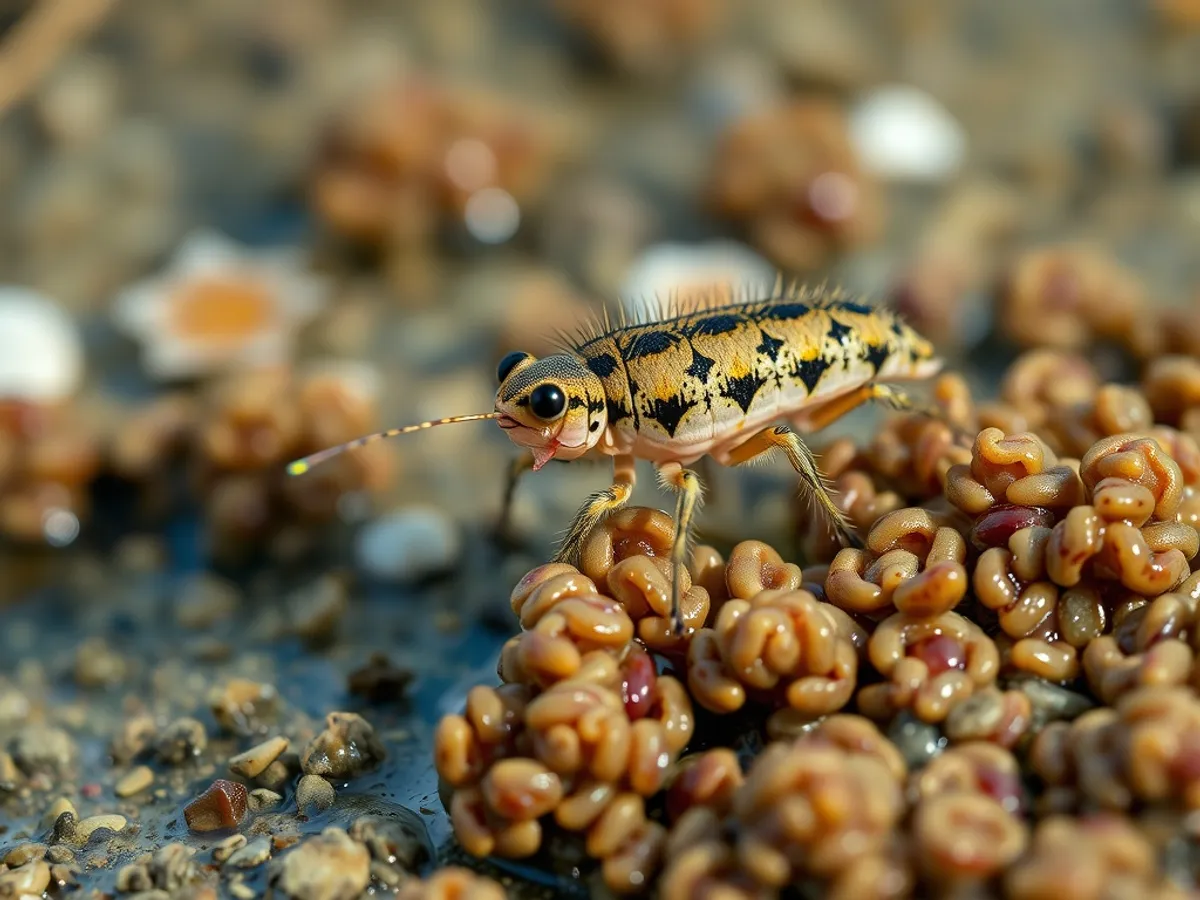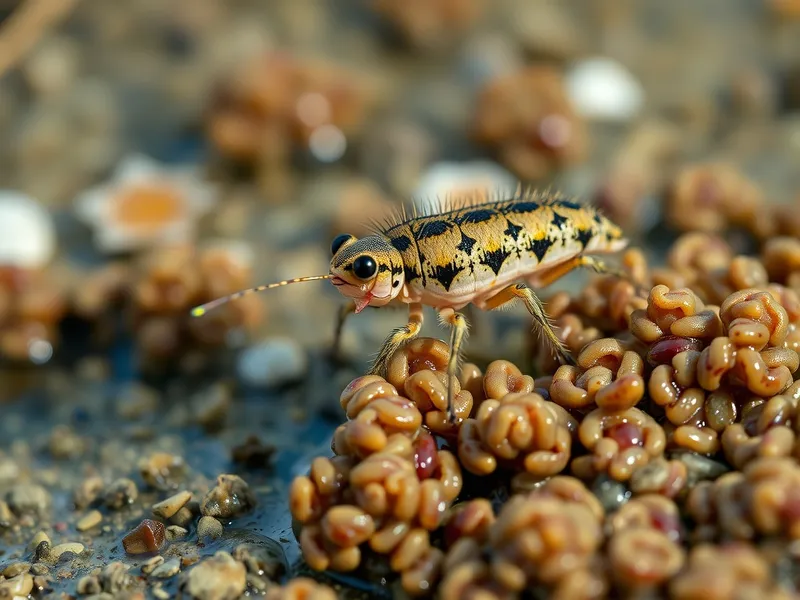
Tarpon springtail
Anurida maritima

Meet the Tarpon springtail
The Tarpon springtail is a tiny, bluish-gray invertebrate commonly found along coastal shorelines and intertidal zones. It is well adapted to life at the interface of land and sea, where it scavenges organic debris on rocks and among seaweed. This springtail is notable for its ability to survive submersion in saltwater due to a waxy cuticle that helps repel water. Despite its minute size, it plays an important role in breaking down decaying matter and recycling nutrients in coastal ecosystems.
Classification
Invertebrate
Habitat
Intertidal shoreline
Diet
Detritivore
Lifespan
Up to 1 year
Conservation
Least Concern
Weight
0.1–1 mg
📖Fascinating Facts
Intertidal Resident
Tarpon springtails are one of the few springtail species adapted to life in salty, intertidal environments.
Spring Mechanism
Their furcula acts like a spring, allowing them to leap many times their body length to escape danger.
Water Repellent
A waxy cuticle coats their body, protecting them from both saltwater and desiccation.
📋Detailed Description
Anurida maritima, commonly known as the Tarpon springtail, is a small, wingless hexapod typically measuring 1.5–2.5 mm in length. Its body is soft, elongated, and covered with fine, bluish-gray scales that impart a metallic sheen and aid in water repellency. The species lacks eyes and pigment, an adaptation to its often shaded, intertidal habitat. Unlike many springtails, A. maritima has a reduced or absent furcula (the forked jumping organ), reflecting its adaptation to a life spent crawling rather than leaping. Its antennae are relatively long and segmented, used for tactile exploration and chemical sensing. The cuticle is covered with hydrophobic waxes, allowing the animal to resist wetting and survive both immersion in seawater and exposure to air. Anurida maritima is gregarious, often forming dense aggregations on rocks, seaweed, and tidal pools, where it scavenges organic detritus. Its ability to withstand fluctuating salinity and oxygen levels is remarkable, and it can survive prolonged submersion by trapping a thin layer of air around its body. The species plays a vital ecological role in nutrient cycling within the intertidal zone, breaking down decaying algae and animal matter.
💡 Did you know?
Despite living at the ocean's edge, Tarpon springtails cannot swim and rely on surface tension and their springing ability to avoid drowning.
🔬Research & Sources
🎭Behavior & Social Structure
Anurida maritima exhibits pronounced gregarious behavior, frequently forming large, dense clusters that can number in the thousands. These aggregations are believed to provide protection from desiccation, predation, and environmental stress. The species is primarily active during low tide, when exposed surfaces become accessible. Feeding occurs on decaying organic matter, microalgae, and microbial biofilms, using specialized mouthparts to scrape or ingest soft material. The Tarpon springtail does not hunt live prey but may opportunistically consume dead invertebrates. Social interactions are mediated by chemical cues, and individuals often follow pheromone trails laid by conspecifics. Daily activity is closely tied to tidal cycles, with springtails retreating into crevices or beneath seaweed during high tide or when conditions become too dry.
👶Reproduction & Life Cycle
Reproduction in Anurida maritima is sexual, with males depositing spermatophores (sperm packets) on the substrate, which are then picked up by females. Courtship involves tactile and chemical signaling, with males often engaging in antennal contact and ritualized movements to attract females. Eggs are laid in moist microhabitats, such as under rocks or within algal mats, and are coated with a protective layer to prevent desiccation and salt intrusion. Embryonic development is direct, with no larval stage; juveniles resemble miniature adults and undergo successive molts. Breeding can occur year-round in temperate regions, but peaks are often observed in spring and autumn, coinciding with optimal moisture and temperature conditions. Parental care is minimal, with females sometimes guarding egg clusters briefly after laying.
🛡️Adaptations & Survival
Anurida maritima demonstrates several key adaptations for intertidal survival. Its hydrophobic cuticle prevents waterlogging and facilitates gas exchange even when submerged. The absence of eyes reduces water loss and is an energy-saving adaptation to the low-light environment under rocks and seaweed. The reduction or loss of the furcula minimizes the risk of being swept away by waves. The ability to form aggregations helps maintain humidity and reduces individual exposure to environmental extremes. Physiologically, the species can tolerate rapid changes in salinity and oxygen levels, using cuticular respiration and metabolic depression during submersion. Behavioral adaptations include synchronization with tidal rhythms and the use of chemical communication for aggregation and mate finding.
📚Research Sources
🎨Cultural Significance
Anurida maritima has limited direct cultural significance due to its minute size and cryptic lifestyle. It is occasionally referenced in scientific literature as a model organism for studying intertidal adaptation and microarthropod ecology. The species is sometimes mentioned in educational materials highlighting the diversity and ecological importance of springtails in coastal ecosystems. There are no known traditional uses or symbolic associations in folklore.
🔬Recent Research & Discoveries
Recent research on Anurida maritima has focused on its physiological adaptations to intertidal life, particularly its cuticular structure and mechanisms of osmoregulation. Studies have examined its aggregation behavior, revealing the role of pheromones and environmental cues in group formation. Molecular work has clarified its phylogenetic position within Collembola and its evolutionary divergence from terrestrial relatives. Ongoing research investigates the impact of microplastics and pollutants on its health and population dynamics, as well as its potential as a bioindicator for intertidal ecosystem health.
🎥Wildlife Videos

Creatures Of The Volcano
A million years ago, Italy was shaped by violent volcanic activity that created mountains and destroyed valleys in a lifeless world.
All Out Wildlife

Pov: Wildlife Photographer 🤣💔
Agent Of Laughter

WILD Eagle Captured by Wildlife Photographer
wildlife #eagle #photography Mastering wildlife photography gear requires patience and skill when documenting birds of prey ...
SoLo in Jungle

WILD Eagle Captured by Wildlife Photographer
wildlife #eagle #photography Mastering wildlife photography gear requires patience and skill when documenting birds of prey ...
SoLo in Jungle

Learn the key secrets to become a successful nature & wildlife photographer with Paul Nicklen
National Geographic, conservationist, wildlife and art photographer, Paul Nicklen has released his first and only Masterclass to ...
Masters of Photography

The life of a wildlife photographer
Journey with Jaguars
🌍Habitat Information
The Tarpon springtail typically inhabits Intertidal shoreline environments. Tarpon springtails have adapted to their environments with specialized features and behaviors.
Primary Habitat:
Intertidal shoreline
More detailed habitat information will be available soon.
🛡️Conservation Status
The Tarpon springtail is currently classified as Least Concern. Conservation efforts are crucial for preserving this species for future generations.
Common Threats:
- 🏠Habitat loss and fragmentation
- 🌡️Climate change impacts
- 🎯Hunting and poaching
- 🏭Human-wildlife conflict
⚠️Threats & Conservation Challenges
Currently, Anurida maritima faces few direct threats and is classified as Least Concern. However, localized threats include habitat disturbance from coastal development, pollution (especially oil spills and heavy metals), and climate change-induced alterations in tidal regimes and temperature. The species is sensitive to prolonged desiccation and may be vulnerable to increased frequency of extreme weather events. Despite these challenges, its wide distribution and high reproductive capacity contribute to stable population trends. Monitoring is recommended in areas experiencing rapid environmental change.
🔬Scientific Classification
Scientific Name
Anurida maritima
Classification Hierarchy
🔍 About Taxonomic Classification
Taxonomic classification is a hierarchical system used by scientists to classify and organize living organisms based on shared characteristics and evolutionary relationships.
The system moves from broad categories (Kingdom) to increasingly specific ones, with each animal's scientific name typically consisting of its Genus and species.
📝Community Notes
Share your observations and insights about the Tarpon springtail with our community of wildlife enthusiasts.
Join Our Community
Sign in to share your observations and connect with fellow wildlife enthusiasts.
Sign In to ContributeNo community notes yet
Be the first to share your observations about the Tarpon springtail!
Explore Tarpon springtail
Select a tab above to learn more about this amazing animal.
📸Photo Gallery
No photos available for this animal yet.
🌟Discover More Wildlife
Continue your journey of discovery with more fascinating animals from our database
